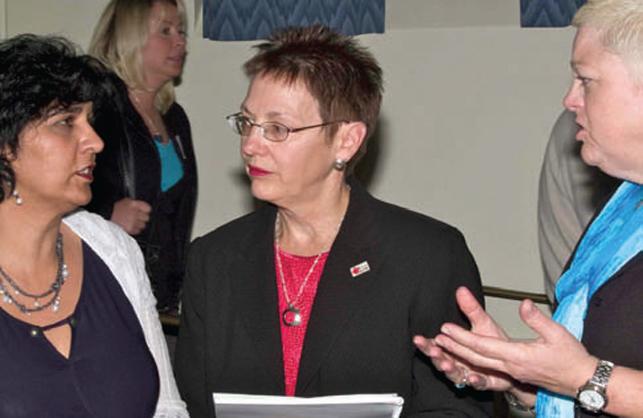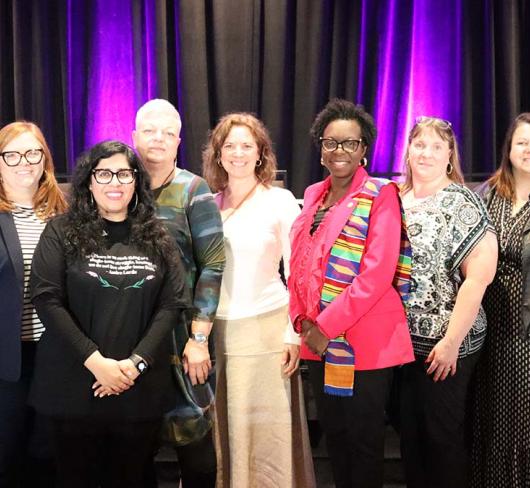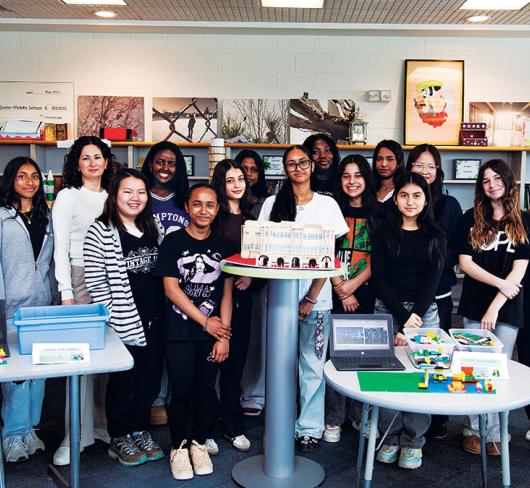
Experienced Players Hooked on Challenge of Negotiations
Like many other ETFO leaders, Julie Stanley brings years of experience to her position as chief negotiator for the Bluewater Teacher Local. Stanley is typical of a unique group of experienced women negotiators leading collective bargaining teams across the province. She was lured by a zest for life-long learning, a deep commitment to improved working conditions, a willingness to accept a challenge, and a belief in the value of building positive relationships.
Stanley joined the bargaining team at a time when she found herself seeking out new challenges. “That tap on the shoulder and encouragement of my local leadership in 1998−99 was one of the reasons I joined the collective bargaining team. We were charged with the task of negotiating the first agreement following amalgamation,” she recalls. “ETFO offered leadership opportunities I wasn’t getting in my school board unless I wanted to become an administrator. Being on the bargaining team was a good way to stay informed about what was going on within the federation as well as within the board.”
Stanley was confronted with a steep learning curve. She says ETFO women’s-only workshops and leadership training, networking with other chief negotiators, and mentorship from her predecessor helped her adjust to the challenges of the game. Terry Card, president of Thames Valley Occasional Teachers’ Local, also accepted the challenge of negotiating the first collective agreement of amalgamation.
"When the unions were amalgamated, I went to a meeting to see how my life was going to change. That’s when I decided this is really going to affect me, and if it’s going to be that important to me, I really wanted to have a say in what it was."
“I started off by joining the executive, learned that we were working on our first collective agreement, and participated in that process as an observer in the early stages. It takes a while to get your bearings and see the big picture. Once I realized what it was all about, I felt I had something to offer. People seemed to appreciate my input, so I stayed on,” says Card.
“The initial agreement was the most challenging one that I ever negotiated. We began in 1998, and signed in May 2000, narrowly avoiding a strike. We had made up our minds to settle for nothing less than we had in any of the former boards.”
Two years later, Card moved into her current role as president and chief negotiator, leading a team whose members were selected because of their experience, talent with numbers, understanding of contract language, and communication skills. She believes not all training is formal: “I learn from everyone. To improve, I watch the staff officer, and talk to peers.”
In the Upper Grand Teacher Local, Ruth McLean could no longer resist the call to broaden her leadership skills by joining the collective bargaining team in 2001, despite abusy life juggling teaching, single parenthood, and union involvement. “When I started getting interested in negotiating, I realized it was an important part of overall leadership development. It was an area I hadn’t gotten involved in yet. Before that, I had three small children and was a single parent. I could only cope with going to work every day. I couldn’t give a lot of time to the union. I was involved, but I knew negotiations took a lot of after-school time. As the children grew, I had more time, and I could get more involved.” By 2002 she assumed the role of vice-president, moving on to become president of the local in 2004.
“I had a lot of experience in the union with committee work. The summer before I became president, I read books on leadership and women in leadership to prepare myself. I also spent time teaching myself about negotiations and how that whole flow chart works, so I felt pretty confident,” McLean reflects. She also attended provincial workshops. Her local’s past president, Marina Howlett, provided a tough, collaborative, and effective role model.
Experience and skill
Steeped in experience, all three women bring similar skill sets to the table. “Negotiators need good communications skills, mutual respect, a collaborative attitude, and good day-to-day working relationships with the board,” according to McLean. “Good organizational and presentation skills are also key.”
To that list, Stanley would add the ability to solve problems creatively, flexibility, and a good memory. “You have to be willing to take a risk, and able to think clearly with little sleep. And you have to remember that you don’t know everything. I rely on everyone else on the team for input; my president and vice-president definitely.”
Terry Card believes that “having a broad picture of the perspectives of the board, your local membership, and provincial issues is important. Having patience, and an understanding that progress can be slow and incremental, are essential. Building a strong collective agreement takes time. You also have to communicate so that your members know where you’ve been, and where you’re going.”
Communicating with members is important, but it’s equally important to communicate with administration, Ruth McLean argues. “Laying the groundwork for negotiations starts years before in labour management meetings, when you’re suggesting solutions. It only culminates at negotiations. At that point, you put the suggestions into collective agreement language and bargain them. By then, they’re not new to management. They’re used to it and expect to see it at the table.”
“I’m not one to butt heads,” McLean continued. “I have a strong belief in the power of positive relationships; that may be seen as more of a feminine trait but I’m sure there are some men who approach it this way too. Once you get the other side to understand the problem, there’s mutual goodwill to come up with a solution.
“When things get difficult, I’ll be tough,” Card adds. “I’ll stick to what I think, but to be effective, you have to be collaborative. You have to understand the other side’s problem. When you can show them you do, they appreciate it. Then you try to explain your side and get at what can be done to address the issue. Not everyone has that style. No matter how collaborative you want to be, if management doesn’t, you’re stuck.”
Card agrees that differences in the way people approach negotiating are more often related to personality than gender: “I’ve only worked with one male staff officer, the rest have been female.” Julie Stanley can’t comment on differences between male and female negotiating styles, since in the last few years all of her table teams have been women only. Provincial numbers indicate that about 60 percent of chief negotiators or presidents serving as such are female, so it’s not so surprising these three locals have limited experience with male negotiators and/or staff officers.
“We always try to have at least one man on our committee,” Stanley says, “but they seem to have other things come up and they’re unable to stay on. We train them, but before they really get to sink their teeth into it, they’re on to something else. Having men on the committee is not so much a question of equity, it’s a matter of representation of your membership.”
Challenges and rewards
Each of these leaders is energized by the challenge of meeting the demands of her position. For McLean one of the biggest challenges is creating a solution that’s doable and acceptable to the other side on issues like workload. Her greatest reward, and one of the reasons she enjoys negotiating, is seeing areas of concern get addressed and the local’s ideas come to fruition: “We worked for years to get gains in our top-up for maternity leave, and an increase to eight hours from seven for EI. Finally, this round was successful. That was gratifying.” According to Terry Card, “Negotiating isn’t much different than occasional teaching. If you’ve prepared the best you can, then you enter negotiations with confidence. You anticipate responses from the board, so you can develop strategies.” Card takes advantage of every opportunity to educate the board about issues unique to occasional teachers. With each changeover in administration, the education process begins again. But seeing how each agreement builds toward improvement keeps her in the game. Keeping her eye on the prize is key, Card acknowledges: “The biggest reward is always getting a good agreement.”
Julie Stanley agrees. “In the end, the biggest reward is reaching a deal, and knowing you’ve helped make positive changes in a collective agreement that’s going to improve members’ working conditions. Every day when you answer questions, you know you’ve helped someone.” But Stanley admits it’s sometimes difficult to keep things in perspective. “Juggling school, ETFO obligations, and personal life is difficult during negotiations. You have two jobs. I could go a whole year and not be at school five days in a row, yet I was still preparing, evaluating, and doing report cards as a full- time teacher. Now I have .4 release time. That has made a huge difference. I now schedule time for myself on Tuesday nights to play volleyball.”
Comparing negotiating to a game in which everyone plays a role, Stanley explains that the team gets to know each other’s strengths and weaknesses and learns to recognize how they complement each other. “There’s a lot of wait and see. There’s making a wish list, and being willing to let go of certain things in order to get what you really need out of a deal,” she says. In the end, debriefing with chocolate and humour helps the Bluewater team keep its perspective. It’s a strategy few would argue against.

